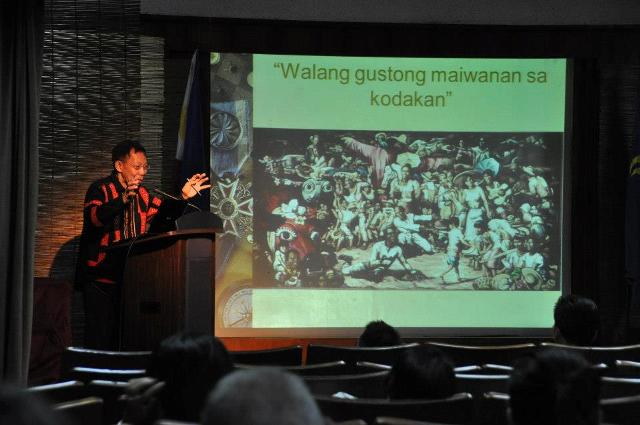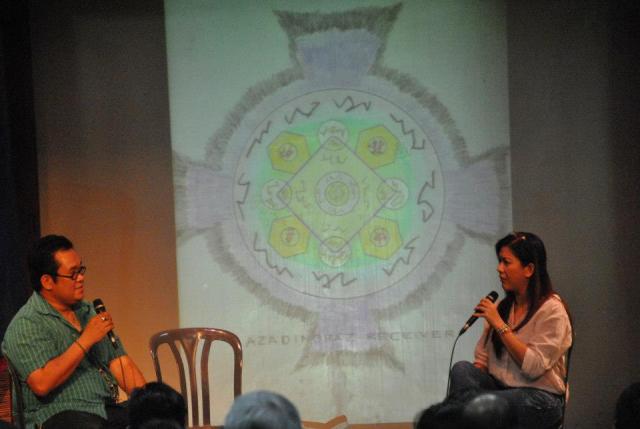Filtered By: Lifestyle
Lifestyle
Reconnecting to our inner anting-anting
By SYLVIA MAYUGA

NCCA chairman Felipe de Leon explains the Filipino’s “relational universe” to a rapt audience. The NCCA has declared as its primary goal the expansion of present Filipino consciousness to its original reality.
What a strange two days those were in Intramuros last October, with anting-antings (amulets), sigils (magical symbols), oraciones (power prayers), and taladros (power images) flashing on a theater screen. "Light and Mystery: Katutubong Karunungan" was a lecture series with researchers and practitioners speaking intimately about our native shaman/healer, the babaylan. The separate reality most of our rural and urban folk live in had taken over a rapt, mostly middle-class, audience at the National Commission of Culture and the Arts (NCCA). Felipe de Leon, Jr., former dean of the UP College of Humanities, now chair of both UNESCO Philippines and the NCCA, gave the main lecture. Also a composer and lifelong interpreter of Filipino culture, he wore the babaylan garb of the Sulod Bukidnon as he unravelled the cosmology of the Filipino universe in lihim na karunungan, that hidden knowledge city slickers associate with hilots and faith healing. De Leon named the key to this ever-present but largely hidden reality: loob—the inner self. “It’s the creative living principle symbolized by the sun," he said. "From physical states, sensory experience and feeling, it goes upwards to the less and less physical, from mind to soul to noumena—the unformed ground of Being. The illusion of separateness comes from seeing only the physical. Filipinos know we are grounded in one being.” The “sacred innermost core of loob, ubud, is divine spirit: laya.” The fascinating "laya" has a Sanskrit root—"li"—and many meanings: “a place of rest, a swoon, a pause in music, a union of song, dance and instrumental music.” The guru Ramana Maharshi gives a more embracing meaning in Upadesa Saram: "This is a means of mind control.The mind becomes quiescent by regulation of breath, like a bird caught in a net." Yoga! Who knew that the Filipino word for “freedom” had such an ancient root? Such questions hung in the air as de Leon proceeded to the recent book, "Larawan ng Loob at Contemplatibong Panalangin." Malay tao, original awareness, wrote Dr. Susan Reyes, descends from spirit, buddhi, to the human soul, bait. “It becomes denser and denser as it descends to the gaseous, liquid and solid states of the physical level." Here was the cutting edge: individual waves of native consciousness with Bathala (God) as ocean depths were severed from their roots when the so-called indio “degenerated into obedience” to Christian concepts. Abduction to an alien worldview under colonial Spanish Catholicism had a high price. In the Spanish centuries a horrifying harridan rose in folk imagination—the batwinged mananggal with a disconnected torso flying in search of human flesh to feed on. A more powerful symbol of a dislocated native soul is hard to find. “We are still in a state of neurosis. We must know what the problem is, recognize and reconnect to our anting-anting, the goodness and creativity within,” de Leon said soberly. “The Filipino is still afflicted by the curse of smallness. We were made to feel so small by our colonizers. The Americans declared the sampaguita our national flower and the maya, our national bird. Even our bahay kubo was translated to ‘My nipa hut is very small.’ We were told to be proud of having the world’s smallest fish, not knowing that we also have the biggest fish in the world, the butanding. “We were made to feel inferior, ashamed of anything local and indigenous. So we celebrate defeats like the Fall of Maynila, the death of Rizal, and the Fall of Bataan. We hide our genius. We don’t develop our pharmacopeia or our water travel. Even our names, like Ma. Antoinette Duga-Duga and Byron Brian, promote weakness, the Doña Victorina syndrome. With such a shady identity, we have no strong impact on the world because we are so indeterminate. We have to cure these weaknesses.” But how? De Leon pointed to remembering. “We are all interconnected. The Filipino is not dualistic. He does not make distinctions between matter and spirit like Western science. God and nature spirits are in this world. Our universe is not governed lifelessly, mechanically like Newton’s. Filipinos are a mythic people. Our sense of space and time is simultaneous: past, present and future are one, not trapped by linear time. It’s synchronistic. This is a psychic quality. The universe is a given but visible and invisible exist in one and the same world. Filipino logic unites the opposites. They are not made to clash but get together gradually. “The philosopher Virgilio Enriquez once said, ‘Ang kapwa ay sarili din,’ a fellow human being is myself,” he mused. “In this society of beings, our core values are kapwa, we are one. Pakiramdam, shared inner perception. Kagandahang loob, beauty of inner self. Pakikipagkapwa means relating to others as one’s self. “There is no ‘Other’ in Filipino psychology. We are a highly relational people.” Even our relationship to the divine is personal, he pointed out. The courteous Tagalog assent, “opo," is short for 'Oo, Poon'—'Yes, Lord',” he believes. We’re also “natural social networkers, number one in Facebook and texting. It’s the essential joy of the human spirit, which is why we love happy endings.” This, too, is why the NCCA has been flooded with nominations for the comedian Dolphy as National Artist. And have you wondered why Filipinos don’t announce their presence but quietly weave into social gatherings? “We don’t want to distract the social harmony in process. We know our place, able to adjust our attitudes and relationships for complete harmony.” What about our irrepressible inventiveness? “Imagination seeks fulfillment in creativity while insisting on togetherness. This makes Filipinos highly creative not in mechanical products but in interpersonal relations and communications, with a symphonic wealth of techniques for connecting to other people.” And what about all that anting “mumbo jumbo”? “Underlying our sense of oneness is a magical worldview, the relatedness of all things. Filipinos consider animals, brothers; we have crocodile totems and salamanders as totems against fire. Our people pray to salamanders as well as to the Virgin Mary. It’s a shamanic, babaylanic consciousness.” This, he said, is the source of “invulnerability to the natural elements—fire, earth, water, air.”  We share anting mythology with our kin in Mindanao, Malaysia and Indonesia. It’s been with our people for so long that even the ilustrado Trinidad Pardo de Tavera defined the anting of unlettered indios as "an amulet of supernatural power that saves lives.” “In Cavite they hack flesh with sharp blades but don’t wound. It can’t be explained by physics,” de Leon pointed out. This unexplainable power, he says, is “why Filipino culture is a natural at healing. It harmonizes human faculties, society and the environment. It’s called hiyang, creative harmony with all levels of being. It can be developed to tune in to any level of reality.” The NCCA has declared the expansion of Filipino consiousness to its original reality as a primary goal. “The anting-anting is our genius as a people. We should realize our strengths so we can use them for our development. We’ve shifted from [being] very generic in promoting national culture and identity to culture as the wellspring of national and global well-being. We have many things to offer, starting with the concept of kapwa. As a Croatian psychologist observed, ‘If there is no ‘Other,’ there is no war’.” A Memorandum of Agreement to introduce this kind of program in Grade 12 has recently been signed with the Department of Education under its activist Secretary, Brother Armin Luistro. Great changes loom. — BM/HS, GMA News
We share anting mythology with our kin in Mindanao, Malaysia and Indonesia. It’s been with our people for so long that even the ilustrado Trinidad Pardo de Tavera defined the anting of unlettered indios as "an amulet of supernatural power that saves lives.” “In Cavite they hack flesh with sharp blades but don’t wound. It can’t be explained by physics,” de Leon pointed out. This unexplainable power, he says, is “why Filipino culture is a natural at healing. It harmonizes human faculties, society and the environment. It’s called hiyang, creative harmony with all levels of being. It can be developed to tune in to any level of reality.” The NCCA has declared the expansion of Filipino consiousness to its original reality as a primary goal. “The anting-anting is our genius as a people. We should realize our strengths so we can use them for our development. We’ve shifted from [being] very generic in promoting national culture and identity to culture as the wellspring of national and global well-being. We have many things to offer, starting with the concept of kapwa. As a Croatian psychologist observed, ‘If there is no ‘Other,’ there is no war’.” A Memorandum of Agreement to introduce this kind of program in Grade 12 has recently been signed with the Department of Education under its activist Secretary, Brother Armin Luistro. Great changes loom. — BM/HS, GMA News

Manuel Solomon Sandiego, both medical doctor and alternative healer, received a “call” to heal in the old way of “lihim na karunungan” early in life. He explains the “sigil,” a symbol powered by oraciones or magical prayers, to interviewer Anna Varona.
More Videos
Most Popular



